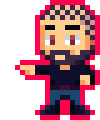PogoGirl Devlog #2: Bouncing Science
When you have a player character that should always bounce, a couple of obvious questions present themselves: How should they bounce? How high should they bounce? How quickly should they bounce? Questions like that form the basis of the entire gameplay concept, so it’s very important to tackle them as early as possible…even if you’ll often end up tackling them a few more times before the game ships. Here are the answers I’ve worked out for now.
How should they bounce? The main point here is whether players should be able to perform or influence the bouncing themselves. For example, they could be required to regularly press A when PogoGirl touches the ground in order to keep her bouncing. This would of course make the game more challenging, but in my eyes also a lot more tedious. Since Go! Go! PogoGirl is meant to be a platformer that just so happens to have constant bouncing in it, I decided against putting too much focus on the act of bouncing as such. Therefore, PogoGirl will always keep bouncing without input from the player.

How high should they bounce? This is something that can have huge effects on the level design, so it’s important to at least have a basic idea. If PogoGirl could only bounce about 1 tile high that would make the pogo mechanic almost pointless, as it wouldn’t feel that much different than a regular platformer. Plus, you’d be severely restricted in designing levels because she can’t cover distances and doesn’t get high enough to bounce over a lot of things. However, if you make her bounce too high, the levels end up being too open and the gameplay too lose. So finding a good middle ground is important, and that’s what I think I found. PogoGirl’s current bounce height lets her navigate platforms and jump over gaps, while keeping the level elements close enough together so that players (hopefully) won’t get lost. And enemies can be avoided or attacked while still providing a challenge.

How quickly should they bounce? This is tied to the bounce force and the gravity. If you crank up both, you’ll end up with very energetic and fast bouncing, which would make gameplay hectic and difficult to control. Make gravity too low and the game becomes floaty and boring. In platformers, your movement mechanics decide how you play the game, so they have to feel good. And the best way to achieve that usually ends up being trial and error. I tied the movement variables to HaxeFlixel’s debug console so that I could adjust them on the fly during gameplay. Then I’d just bounce around, fiddle with the values, then bounce some more…until I found values that worked for me. Keep in mind that I might actually end up slightly changing these values later on, as that’s the nature of gamedev. But for now I feel like I struck a good balance between maneuverability and a satisfying boing. If you know what I mean.
Bad movement can instantly kill a platformer or at least drag it down very, very far. Think of games like Bubsy: The movement controls in that seem to have been made for an entirely different game. Bubsy’s movement is very momentum-based and his top speed is waaaay too high for the level design and obstacles you have to avoid. If the movement mechanics had been different (i.e. sensible), I’m pretty sure the game would be remembered much more fondly.
So I guess what I’m saying is PogoGirl will be better than Bubsy.

Want To Buy Me a Coffee?
Coffee rules, and it keeps me going! I'll take beer too, though.

Related Posts
Go! Go! Pogogirl Is Coming to Mega Drive!
It is finally happening: Go! Go! PogoGirl is coming to the Sega Mega Drive!
Kid Bubblegum Devlog #2
And we’re back again with more Kid Bubblegum! First of all, the game now has a Steam page, so I’d be tickled bubblegum pink if you could hop on over there and wishlist the game. It helps a lot! Now to the game itself. This week was spent building a few levels, making a new enemy type and polishing the game up to a basic state…just like I had planned to do.
Comments
By using the Disqus service you confirm that you have read and agreed to the privacy policy.
comments powered by Disqus

